Features of Ecological Architecture of Iran Deserts (Using the Teachings of Traditional Architecture)
Mohammadreza Hatamian1 , Mostafa Azad1 * , Java Divandari1 and Mansoureh Tahbaz2
1
Faculty of Architecture and Art,
University of Kashan,
Kashan,
Iran
2
Faculty of Architecture and Urban,
martyr Beheshti University,
Tehran
Iran
DOI: http://dx.doi.org/10.12944/CWE.10.Special-Issue1.99
A vast area of Iran is covered by desert areas having tough climate along with sensitive and risky ecosystem which is being lost increasingly in case of negligence and the wilderness of deserts will be increased accordingly. Such regions hold plenty of capabilities in the field of investment and tourist attractions. Moreover, it’s necessary to implement all activities conducted in the areas by the use of stabilization and desertification approaches. In this way, architecture and urbanism whether in city scales or in smaller scales such as villages and oases plays remarkable role in this matter and it is possible to go through this path by the use of construction in harmony with the natural environment. Certain requirement of sustainable construction which is compatible with the region environment is to identify characteristics of ecological architecture of desert areas. In construction terms, our ancestors also used to pay special attention to the harmony with the environment so that one of the assisting information sources in this matter is their experiences. Therefore, in the actual research after explaining the concept of “Ecology”, ecological features of Iran desert areas are extracted and categorized based on the research records and field studies of desert area in Maranjab area in order to achieve solutions in harmony with dry and tough climate. The research results suggests in spite of tough environmental situations of such areas, environmental conditions for human comfort is provided by recognizing ecological features and using engineering sciences.
The main research question: What are features of ecological architecture of Iran deserts?
Copy the following to cite this article:
Divandari J, Tahbaz M, Hatamian M, Azad M. Features of Ecological Architecture of Iran Deserts (Using the Teachings of Traditional Architecture). Special Issue of Curr World Environ 2015;10(Special Issue May 2015). DOI:http://dx.doi.org/10.12944/CWE.10.Special-Issue1.99
Copy the following to cite this URL:
Divandari J, Tahbaz M, Hatamian M, Azad M. Features of Ecological Architecture of Iran Deserts (Using the Teachings of Traditional Architecture). Special Issue of Curr World Environ 2015;10(Special Issue May 2015). Available from: http://cwejournal.org?p=756/
Download article (pdf)
Citation Manager
Publish History
Select type of program for download
| Endnote EndNote format (Mac & Win) | |
| Reference Manager Ris format (Win only) | |
| Procite Ris format (Win only) | |
| Medlars Format | |
| RefWorks Format RefWorks format (Mac & Win) | |
| BibTex Format BibTex format (Mac & Win) |
Article Publishing History
| Received: | 2014-11-14 |
|---|---|
| Accepted: | 2014-11-28 |
Introduction
Desert areas provide hard and tough living conditions and living there requires special measures which raise man to challenge. Due to abundance of desert area in our countries, human being is forced to find certain solutions for living in such areas. Gift of thinking which has been endowed by God to the human is a tool for finding solutions in this matter. It’s required to have comprehensive and thorough understanding over living conditions of the area in order to stylize the living conditions and to create inhibiting comforts. One of the main questions of the present research is” what are the ecological features of Iran desert areas?” that answering to it identifies environmental conditions of the area.
In addition to having adequate information over the area, presence and activity in such areas requires providing shelters as well. Considering specific conditions of the area, it holds a particular architecture which must be compatible with the environmental conditions. Another question which answers to such issue is “how is ecological approach emerged in the architecture? On the other hand, “ what are the components of the ecological architecture?”
In recent times, we have witnessed the nature destruction and ecosystem loss in the world or in our country due to human’s over interventions and his bullies; especially desert ecosystem which has poor ability of restoration and the rate of such destruction must be reduced as proper solutions must be devised in this issue. The objective of the actual research is to find architectural approaches in harmony with climate of Iran desert areas in order to prevent desertification as well as growing and flourishing the desert areas by penetrating into them. Harmony in our ancestors’ life and architecture has made their experience as a fruitful guidance in the way of finding one of the best answers.
Review of Literature
Architectural features of desert cities are one of the study areas of the research which has been studied in various views. Naghizadeh and Aminzadeh (2001) studied ancient architecture and urbanism of desert areas and they pointed to certain features. Naghizadeh in an another source (2001) studied the features of desert areas with Islamic worldview that the result of them have been used in the present research and Fanni (2002) and Golkar (1998) studied the features of the desert areas as well as study one specific city. For example, Tahbaz (1995) studied the climate of Zavarreh City. Some of their results are generalizable to certain unites in smaller scale. The research objective is to explain concept of Ecology and to expand and conclude the obtained results in the field of ecological architecture of Iran deserts. It is hoped that by referring to today solutions we could create an executive application for the present and previous study in the final section.
Methodology
The method of the research is applied and data collection method is based on library and internet sources which have been conducted by the use of analytical-descriptive method. Additionally, study results have been compared with the results of other researches and field studies. Deserts of Iran have been regarded as an independent variable and ecological and architectural features have been considered as dependent variables.
Desert
A number of definitions have been given for “Desert” and scientists of each field of study have identified certain features for it based on their own point of view. In a comprehensive definition, Desert means absence of human being or more generally lack of life. In another definition, Deserts are certain lands which are not appropriate for human to live. According to climatologists’ opinion, such elements as rain and temperature play remarkable role in determination of deserts features. Air dryness is one of the main characteristics of desert. (Mahmoudi, 1988) according to Fink, areas with annual rainfall less than 500mm are considered dries and in case such amount is less than 250mm, the area is considered a desert ( Jazireyi, 1992). Coupon considers some regions as deserts where there isn’t adequate rainfall for crops (Khosroshahi, 2005). Another criterion to identify the desert is Geomorphology. It should be noted that geomorphology doesn’t merely offer a reliable description of dry environment, but its accuracy must be evaluated with other criteria and indices and to be used as an index later. Soil science, vegetation and geology criteria are of other criteria for desert identification.
Desert, Sahara and wilderness have various concepts and it’s wrong to consider them unique. Sahara is a specific name for a low- water land and semi-low water in the North Africa spread from Atlantic Ocean to Egypt. Excluding some part of Mediterranean Coast and some scattered mountain areas, various desert conditions dominate everywhere in the Sahara. In Iran, Sahara refers to all geographical phenomena outside of settlements ( Mahmoudi, 1998). Wilderness is a phenomenon related to soil science which is constituted and developed under certain circumstances. Since prevailing conditions in the desert are mostly conductive to the emergence of the deserts, these two phenomena accompany each other most of the time( Mahmoudi, 1988) and it leads to use these two concepts mistakenly. Where there is fine-textures soil and salt in a general sense as well as water presence in any form (rain, current, underground) desert is formed ( Mahmoudi, 1998). As a matter of fact, desert is a complication in the desert. The desert itself often includes a slight area of a desert ( Loot Plain) and it can even give its name to a desert due to its extent (Kavir Plain). Deserts of Iran could be divided into two categories: Costal deserts and inlandl deserts (Mahmoudi, 1988).
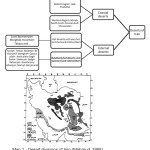 |
|
In terms of reaction, deserts have high vulnerability in spite of having low restoration power and reversibility comparing to the other ecosystems (Fanni, 2002). Problems associated with desertification is so serious so that it requires accurate study the urbanism concept of ecological architecture by proper features compatible with wilderness or desert ecosystems (Fani, 2002). The whole stress human being could experience out of desert areas are dividable into four categories. (Givani, 1988) (Golkar, 2000).
A: The stress from overheating in summer days resulting from temperature and intense sun exposure.
B : The annoying and dazzling sunlight caused by direct or indirect solar radiation.
C: The prevalence of dusty winds mainly in the afternoon.
D: The cold wind flows in winter.
Such stresses stem from the relation with land and environment showing the first priority of comfort in the desert areas is to pay attention to the area ecology.
Ecology
Ecology is made of two Greek words: Oikos that one meaning of it is home and another meaning is expenses and Logos which means knowledge. Such translation prompted some scientists translating Ecology into "بوم شناسی" (science of region) or they have even used the forgotten suffix and translated Ecology into Science of Codes. Now, Oikos in here means income and expenditure and in relation with nature and natural landscapes, it means income and expenditure (Balance) of energy and material in an ecosystem or according to Youhin Edovom, Ecology is to study of planet income and expenditure by considering vegetation, animals, microorganisms and the population living in a habitat altogether by relying on each other (vital fields). ( Bahram Soltani, 1986). Therefore, ecology could be firstly defined as identification knowledge of material and energy income and expenditure in the nature (Bahram Soltani, 1986).
Some have interpreted Ecology as science of the region. Science of the region or ecology is the consequence of environmental thinking and enthusiastic need for independent and proper understanding which is common in the living entities (Omidnia, 1985:28). Such expression was raised for the first time by Ernest Hackle, a German biologist in 1866. It mainly controls relationships of organisms with the environment and from a scientific prospective, it’s the study of distribution and abundance of living, non-living organisms and interactions determining scattering domain and frequency of energy flows in their environment (david.2009 , http.depaul.edu) (Kaviani Nejad, 2010:83). Ecology is defined as a relationship and system between living entities and their living environment in an integrated and related structure.
Each constituent element of the ecology-based structure (Which in turn is too small could be regarded as a systemized structure) must be studied by the use of its life environment and field (Ghaffari Sadeh, 1995). In case the exchange with the natural environment is directly studied, it’s called “Natural Ecology” which accompanies certain cultural systems, values and patterns leading to the exchange with the nature which is indirectly effective on the process of exchange with the ecosystem. Moreover, they are mentioned as “cultural ecology” in the present article. The cultural ecology is mentioned in the components of natural ecology in order to identify better their relationship.
Ecological Architecture
By expansion of concerns related to the nature and natural ecosystems, we have witnessed certain attention to different sciences in order to maintain and stabilize the nature. Moreover, urban design is concerned of preserving land natural sources and wild life (Golkar, 2000) And in smaller scale, one of the main preoccupation of today architecture is environmental protection. Whenever a constructive plan is regarded as a base or instruction before being implemented, it is considered under an ecological evaluation, not only “Construction” will find its actual content, but also future generations will acknowledge their ancestors due to practical accuracy made in relation with environmental perseverance (Bahram Soltani, 1986).
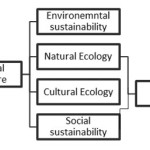 |
Figure1A Click here to View figure |
Having a discussion over the ecological architecture is not an easy task. Ecology is not a specific model of a building, whereas it’s a definable style. There’s no valid ecological solution for all climates. Even if it has reached to a perfection by the use of comprehensive technological rules, there’s no need to say such rules don’t exist (Van, Offlan, 2009) thus, in order to achieve each area technological rules, it’s required to conduct separate and particular study of the same area.
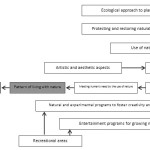 |
Figure1B Click here to View figure |
Ecological Architecture of Iran Deserts
Indwelling man in desert areas hasn’t been possible except in the light of smart exploitation of natural resources as well as softening and adjustment of harsh climate conditions (Golkar, 2000). Islamic thoughts strictly focus more on lesson learning principle from the ancestors and other civilizations. Certain items such as traditions and works could be taken up as one basis of lesson learning. Imam Ali considers lesson learning with piety as one of the salvation elements of human in avoiding commit of doubtful deeds. According to him, lesson learning is one of the Four Branches of Faith. He states: “Certainty holds four branches, smart insight and reception by the use of wisdom, lesson learning from instructive issues and following predecessor’s method. Whoever observes by the use of Sagacity, wisdom emerges to him and when wisdom emerges, he knows how to take lesson from incidents and whoever takes a lesson, as if he had lived with the predecessors (Nahjolbalagheh, p.807). furthermore, he suggests to learn lesson from remained works of the past eras (Naghizadeh and Aminzadeh, 2001).
Study of the traditional structure of Iran deserts suggests our ancestors had specific attention to the nature. Some factors such as natural disasters like climate conditions, ups and downs, winds, water basins, rainfall volume, underground waters, vegetation and land features have had remarkable impact on finding location and oasis formation and they are considered as the main elements of ecology-based structures (Ghaffari Sadeh, 1995). Additionally, Islamic Iranian thought which forms people’s culture is somehow related to the nature and human’s relation with his living area which leads to form ecological architecture in arid areas of Iran. The components of the cultural and natural ecological architecture of Iran deserts are studied in detail as follow:
Considering Water
Water as a lifesaver element plays an essential role in the desert cities. Not only water has been able to turn the arid areas into a habitable area, but also it has role of forming the cities structure in urban scale (Golkar, 2000). Therefore, water supply is the most significant components in creation of settlements in desert areas and it’s impossible to live without any reliable water supply support. On the other hand, it’s required to have precise management over using water in such areas due to excessive water shortage. Habitants of the Central and Eastern parts of Iran used and use various methods for water supply and optimum application of water. They have learnt a number of experiences and skills. Some example of the main methods in this issue is aqueducts, irrigation with jugs, flood control or pond digging, pool irrigation and etc.
Due to limited size, small and ecological cities could generally use interesting techniques such as cistern in order to supply and save drinking water their own habitants (Fanni, 2002). Dependence and self-sufficiency, non-need to fossil fuel, balanced exploitation of underground waters and environmental protection could be mentioned as the main features and advantages of aqueduct (Naghizadeh, 2001). In fact, habitants of the desert area brought underground water to the surface by invention one of the most economical, healthiest, sustainable and engineering methods in order to provide living conditions in arid and dry deserts (Naghizadeh and Aminzadeh, 2001).
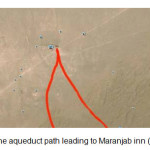 |
|
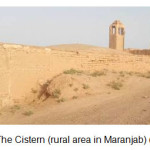 |
|
Consideration of Vegetation
Another environmental component which is considered in desert areas is vegetation. Most areas of desert edges, especially mountains foot are covered with bush lands which play remarkable role in stabilization of the land against wind erosions as well as having outstanding effect on prevention of dust and dirt creation in desert cities (Ghaffari Sadeh, 1995). Due to restrictions of cultivable lands, necessity of maintenance and non-changing their application in city edges is required (Ghaffari Sadeh, 1995). Green area surrounding townships plays two important roles in their lives:
A: As a source of livelihood and production for residents
B: As a green belt which plays a significant role in protecting development against incompatible factors of desert areas such as heat, hot and dry winds carrying dust and sand as well as increasing relative air humidity (Ghaffari Sadeh, 1995). Subsistence supply through near green sources causes independence and self-sufficiency of desert settlements which is of sustainability requirements in tough conditions.
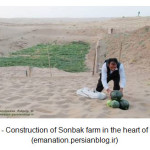 |
|
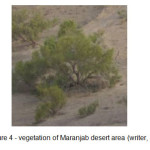 |
|
Consideration of Soil and Land
Initial civilization and primary cities have been extended which could supply sufficient surface and underground water, fertile alluvial soils, agricultural production surplus and when fertility level of the soil was not kept or compensated, or soil degradation bases and level of water sources would appear, so that civilizations used to deteriorate and their population would scatter in other areas (Fanni, 2002). Hence, of the requirement for the settlement sustainability in desert areas, fertile soil could be named in order to be able to create proper vegetation by the use of water sources. On the one hand, infertile land such as sabulous and saline lands which are wasteland causing difficulties in finding fertile soil in desert areas.
Consideration of Wind
Winds and air flows are of the main and effective climate factors in various areas of Iran. The wind flow has been an influential effect on finding locations and oasis form and architecture. Wind variations in terms of direction, speed, humidity amount and season blow has left diverse impact on biological communities (Ghaffari Sadeh, 1995). The areas which are in exposure of dry wind of the North and North-East directions which carry dirt, dust and sand from the Central Plateau of desert areas toward desert edges are considered as significant and effective factors in architectural form and appearance of desert edges cities (Ghaffari Sadeh, 1995).
Accompanying floating sands with the wind blowing from the north causes the erosion and destruction of materials of northern walls having more speed in comparison with other angles, so that there are some inns in the desert areas of the Central wilderness of Iran and Maranjab area that merely northern angle of them has been destroyed.
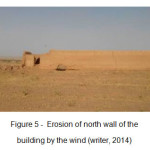 |
|
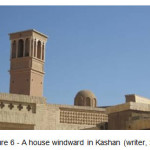 |
|
Shading
Architectures of Iran desert cities used to identify proportions and forms and apply them in their works which were the main factor of shade increase over the surfaces. Moreover, the environmental conditions were supplied in the shelter of high walls or roofs as well as covered paths or trees. Of the solutions of the traditional architects of Iran for the shadow increase over surfaces and maintaining inner parts of the building against outer heat and cold is to use dome form, location in the yard dent, application of windward and construction of basement ( cellar) (Naghizadeh and Aminzadeh, 2001). Creation of the shade in residential units scale is supplied by making certain measurements such as using central yards with high sidewalls and surrounding. Additionally, organic and narrow passages and its sides provide the required shading in scale of city spaces (Golkar, 2000). Some desert cities build their streets and passages covered in order to be compatible with its own ecosystem; such passages were called Sabat or Sunshade (Fanni, 2002). Creation of shade is an identification for the desert ecological architecture and it is needed not to expose the buildings and passages against direct sunlight.
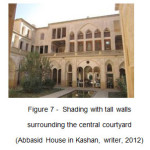 |
|
Energy Supply
Energy supply for the settlements is one of the main human’s needs which mostly accompany negative effects on the nature and it’s needed to consider more care in the instructions and guidelines in this matter. Therefore, sustainable urban design in development of new urban areas is the preoccupation of energy consumption reduction (Golkar, 2000). Namely, in addition of clean energy production, energy saving and reduction of energy consumption should be considered. In the desert areas, upgrading buildings abilities in the provision of internal spaces is in a way which is needed minimum energy consumption along with supply of climate welfare (Golkar, 2000). One of the most common methods in the architecture of desert cities helping in energy consumption saving is using equipment and passive systems elements and installments such as windward, cisterns, fridges, wind and water mills (Golkar, 2000). Application of recyclable energy sources like sun and wind energy is one of the main principles considered by hot, dry and full sun areas (Naghizadeh and Aminzadeh, 2001). In order to maintain and develop the natural sources, it’s required to apply recyclable energy sources and to reduce consumption of seasonal energies and by consideration of the environment and reduction of water, air and soil pollution and harmony with environmental and climate conditions, a balanced environment is provided for human life and continuity of healthy life Naghizadeh , 2001). Another sustainable spontaneous techniques is to use double coverage for external coverage of the house, roof or dome building by the use of materials in accordance with climate conditions which resist transfer of external heat in to the building in addition of coverage lightening. Creation and application of local techniques such as windward could provide coexistence possibility of such cities with dry and rough conditions of the desert (Fanni, 2002).
Considering Animals
Each ecosystem hold particular animals which must be considered in the process of ecological design and their coexistence methods with the nature could be a proper pattern for the human. As thinking over creation of camel who is a desert animal is directly pointed by God in Qoran, certain factors as specific wild life and … could provide suitable context for foreign tourist attraction (Naghizadeh and Aminzadeh, 2001). Due to existence of reptiles, birds and grazers in desert areas, Iran has been a proper attraction.
Recycling
The first principle in sustainable urban design, giving priority to the buildings recycling, facilities, infrastructures and existing road network through being complied with conditions and new needs ( Golkar, 2000). Recycling and re-using buildings could be considered as architecture and urbanism traditions of Iran ( Golkar, 2000). This will save money and energy as well as preserving the memories and the past. Physical development of a city should be in accordance with the surrounding area and the city meets its needs through internal and local facilities and wastes which are being returned into the using cycle sustainably (Fanni, 2002).
Re-purification of sewage and re-using them for irrigation purpose and… as a necessity must be considered in the instructions of decision makers’ elements (Naghizadeh, Amin Zadeh, 2001). It’s not possible to recycle and re-use water in the frame and spatial organization of a small town. However, re-using water in arid areas requires proper policy and planning which is in line with economic necessities and sanitary sufficient controls (Fanni, 2002).
Materials
In the traditional architecture of desert cities, certain materials used which would be digested easily in the nature after demolition of buildings. Additionally, the materials would play an important role in the reflected energy received from the sun and local and available materials had no dependence. In spite of all restrictions, any types of materials would be created by the use of various forms and shapes in a high built environment and a good variety in the space (Naghizadeh and Aminzadeh, 2001). By the use of such tact, in addition of buildings variation, less harm will occur to the nature, less energy is used for material supply and causes energy saving. Adobe (mud bricks), brick and straw are examples of local materials of desert areas of Iran.
The factors which have been mentioned so far are directly in relation with ecology. The second group consists of certain factors associated with people’s culture or society which is indirectly related to ecology.
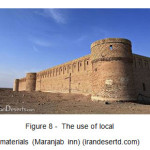 |
|
Human Society
Mostly arid and desert areas accept few human societies and restricted residential communities are created in the edges of such areas because problems in provision and supply of water and rough natural environment creates less compatible basis (Fanni, 2002). Improper cultivation in more lands lead to incorrect and excessive usage of all types of chemical farm inputs. On the other hand, productivity and efficiency increase in agriculture and even industry to meet urban population’s needs has cost the construction of sensitive natural ecosystem, especially dry and arid areas (Fanni, 2002) so that, where each environment with environmental capacities more than their attraction ability and biological action are manipulated, environmental damages are shown as ecological abnormalities including desertification of other zones of the land ( Fanni, 2002). In the ecological design of the desert areas, environmental capacity must be considered and extent of the oases is compatible with the environment capacity in supply of water and fertile land.
Localization
A limited number of cities is found which continues its life by relying on sustainable and local mechanisms (Fanni, 2002). Whereas localization of human settlements causes saving in energy consumption and they will have better accordance with the base. The said items are examples of ecological architectural components. Following the pattern of the region ecosystem and using local materials and technology of each region is a help for cultural and environmental stabilization.
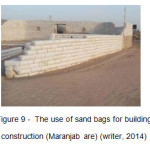 |
Figure 9: The use of sand bags for building construction (Maranjab are) (writer, 2014) Click here to View figure |
Variation of Application
Observation of such principle has been forgotten these days and in contrast with it, urban spotting of applications could be placed fully separate from one another which is in conflict with the ecological approach. Presence of mixed application in the centers of ancient areas of desert regions inhibits residents’ unnecessary trips to various areas for meeting their own needs (Golkar, 2000). Development relying on mixed application by the combination of residential application and employment provide such opportunity for the people to live near their work places, so that urban traffic is decreased ( Fanni, 2002).
Consumption Pattern
Water attitude and sustainable coexistence with the desert requires people reviewing their own life style and consumption pattern for reducing land limited sources by the use of their claims as well as increasing water sources by maintaining, saving and reusing in order to decrease tensions over it (Fanni, 2002) because it’s impossible to live in the absence of water and the settlements life will be terminated. For modification of consumption pattern, public determination is needed and human’s life must be institutionalized in it and proper culture must be made. In desert conditions, the nature determines consumption amount and it must be in accordance with it.
Spirituality
The pressures imposed by the wilderness to the human provides requirements for the emergence of his talents and expression of specific activity patterns ( Naghizadeh, Aminzadeh, 2001). In spite of location of Iran desert cities in difficult climates has shown one of the most appropriate types of relations between human and nature so that such relation could persuade spiritual aspect of human life by induction of spiritual and symbolic concepts in addition of meeting material and spiritual human’s needs (Golkar, 2000). Remembering spiritual principles and values are the subjects which have a significant role in human excellence. Moreover, thought and contact with verses, signs and the nature is specifically considered (Naghizadeh and Aminzadeh, 2001). Architecture of desert areas of Iran holds certain features which has remarkably helped to the emergence of a sustainable spiritual life toward excellence. Such architecture creates an environment or space fo human life by consideration of justice and its sub-categorizations which is the origin of another principle, namely integrity. Such integrity is emerged through various methods. The integrity avaoilable in Iran desert areas has been emerged through using homogeneous and heterogeneous materials, application of suitable geometrical shapes, continuum of elements, spaces and their logical relationship with each other, expression of human scale, using natural elements in proper locations and etc,.. (Naghizadeh, 2001).
Conclusion
Desert ecosystem of Iran is one of the most vulnerable and sensitive area of the country which are highly prone to risk due to negligence of human beings and their harmful actions as well as low restoration power and every action made in such areas should be compatible with the area ecosystem. The science related to this issue is called Ecology. Ecology controls the relationship with the nature. The natural ecology consists of the items which are directly related to the nature and cultural ecology includes all cultural factors pointing to the relationship with the environment and plays a significant role in human being relationships. Ecosystem-based ecology must include both cultural and natural aspects of the ecology. Components of the ecological architecture are specific for each area. The ecological architecture of Iran deserts is in direct relationship with the natural factors. Important components of the architecture is paying attention to water, vegetation, soil and land, wind, wild life and energy supply that each has its own solutions in the traditional architecture and some of these solutions such as considering shading, material recycled materials, accuracy in material selection, using local materials respond simultaneously to several aspects of the mentioned issues. The second category includes all factors which is related to the culture of desert areas habitants creating certain components for the ecological architecture; for example, considering size of human society, localization, using mixed application, modification of consumption pattern and paying attention to hidden spirituality in the nature that consideration of them affects the relation adjustment with the ecosystem. In order to design and construct the ecological architecture in the desert areas, we must consider both parts of the components and the ecological approach must be dominant on other components all the time.
References
- Bahram Soltani. K, A glimpse of natural landscape ecology, (Geographical growth, 1986).
- Chris van Uffelen,Ecological Architecture,(braun Publishing ,2009).
- Z, Urbanization, urban development and integration practices in Iran deserts, 35, ( 2001).
- Ghaffari, A, ecology in the ancient cities of Iran, soffeh,19 and 20 ( 1995).
- Golkar, K, Sustainable urban design around the edge of the deserts, fine arts, 8, (2000).
- Jazireyi, MH, The phenomenon of land, forest and grassland Journal, 13, 14 and 15, (1992).
- Kaviani Rod. M, processing concept of environmental security (relationship of security and Ecology), 3 (2011).
- M ; Mohammad Khan. Sh, Review of concepts and features of the desert, the necessity for a comprehensive approach, Geographical growth, 20(2), ( 2003).
- F, Iranian deserts, (Geographical growth,1988).
- M. ; Aminzadeh. B, study of architecture and desert cities of Iran, deserts, 6(2),( 2001).
- Naghizadeh, M, the Islamic worldview, Sustainability and desert cities of Iran, ecology, 27, (2001).
- Tahbaz, M, Architectural Principles of the desert, soffeh,19 and 20, ( 1995)






